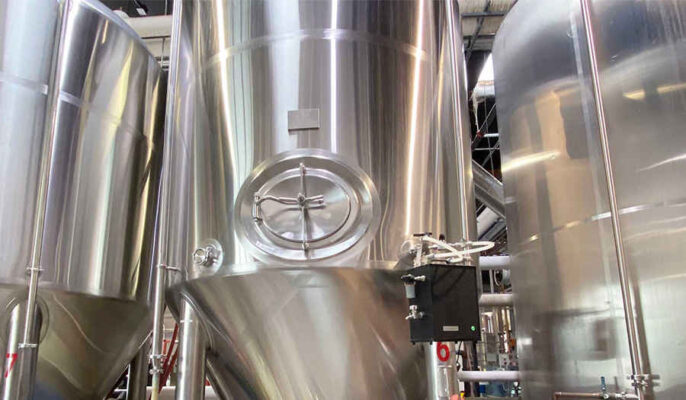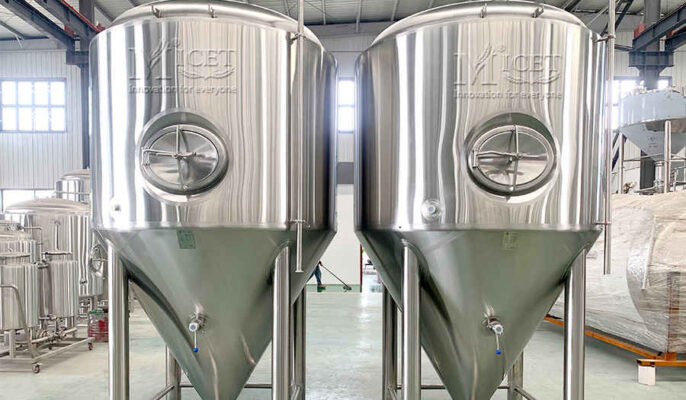From home brewing to commercial brewing, fermentation vessels have always been an essential part. They have changed almost over time. Beer fermentation equipment is divided into fermentation tanks and yeast expansion tanks, which have the functions of raw material preparation, cooking, sterilization, cooling, and so on. The production of fermenter treatment products must be able to provide the conditions required for microbial life activities and metabolism and be easy to operate and control.
Fermenter
Fermenters are the most common fermentation system used in the production of beer today. As the name implies, a closed vessel is a vertical cylinder with a conical bottom and usually a saucer-shaped top. For other simple processes, a fermenter is an open vessel, sometimes as simple as having only one opening. It can also be called an open fermenter.
A qualified fermenter should have the following characteristics:
- Should have a tight structure
- Good liquid mixing characteristics
- Excellent mass transfer phase heat transfer rate
- Equipped with supporting and reliable detection, safety components, and control instruments

Fermentation tank volume
It is generally considered that a fermenter tank below 500L is a laboratory fermenter; a fermenter with a capacity of 500-5000L is a pilot test fermenter; a fermenter above 5000L is a production-scale fermenter.
Cylindrical conical fermenter
The circular simplified conical bottom vertical fermenter (referred to as the conical tank) has been used in the production of beer with top or bottom fermentation. The conical tank can be used alone for pre-fermentation or post-fermentation, or combined pre-fermentation and post-fermentation in the tank (one-pot method).
The advantage of the equipment is that it can shorten the fermentation time and has production flexibility, so it can be suitable for the production of various types of beer.
Features
Such devices are generally placed outdoors. The sterilized fresh wort and yeast enter the tank from the bottom; when the fermentation reaches its peak, all cooling jackets are used to maintain the proper fermentation temperature.
The refrigerant uses ethylene glycol or alcohol solution, and ammonia (evaporated) can also be used as the refrigerant; CO2 gas is discharged from the top of the tank. There are manholes on the tank body and the tank cover, and the tank top is equipped with a pressure gauge, a safety valve, and a glass sight glass.
A purified CO2 gas tube is installed at the bottom of the tank. The tank is equipped with a sampling tube and a thermometer connection. The outside of the equipment is wrapped with a good insulation layer to reduce the loss of cooling capacity.
Advantage:
Low energy consumption and small pipe diameter can reduce production costs.
For the yeast deposited at the bottom of the cone, the valve at the bottom of the cone can be opened to discharge the yeast out of the tank and keep some yeast for next use.

Affecting the cost of fermentation equipment
The size, form, operating pressure and required cooling workload of the fermentation equipment. The form of the container refers to the surface area required per unit volume, expressed in ㎡/100L, which is the main factor affecting the cost.
Tank pressure requirements
Consider carbon dioxide recovery. It is necessary to keep the CO2 in the tank at a certain pressure, so the large tank becomes a pressure tank, and a safety valve needs to be installed.
The working pressure of the tank varies according to the fermentation process. If it is used for both pre-fermentation and wine storage, it should be determined according to the CO2 content during storage, and the required pressure resistance is higher than that of a tank only used for pre-fermentation. When the pressure reaches the design pressure of the storage tank, the safety valve should start to open. The most working pressure of the safety valve is the design pressure plus 10%.
Tank vacuum
The vacuum in the tank is caused by the transfer or internal cleaning of the series of fermentation tanks under closed conditions. The feeding speed of the large fermenter is very fast, and a certain negative pressure is generated. There is a part of CO2 gas remaining in the tank, which may be removed during cleaning, so a vacuum may also be created. Large vacuum fermenters should be equipped with devices to prevent vacuum. The function of the vacuum safety valve is to allow air to enter the tank and establish a pressure balance inside and outside the tank.
According to the alkali content entering the cleaning solution, the CO2 removal amount in the tank can be calculated, and the amount of air that needs to enter the tank can be further calculated.
Convection and heat exchange in the tank
The convection of the fermentation broth in the fermenter depends on the effect of CO2. The entire fermentation liquid in the conical tank forms a carbon dioxide content gradient. Fermented liquid with a smaller specific gravity has a lift to float upwards.
Also, rising carbon dioxide bubbles during fermentation have a drag on the surrounding liquid. Due to the agitation of the gas generated by the drag force and the lift force, the contents of the tank are circulated and the mixed-phase heat exchange of the fermentation liquid is promoted. Changes in beer temperature during cooling operations can also cause convective circulation of the tank contents.




